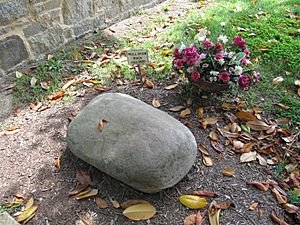Moll Dyer facts for kids
Moll Dyer (died around 1697) is a famous legend from the 1600s in Leonardtown, Maryland. People say she was accused of witchcraft and forced out of her home on a cold winter night. Her body was found a few days later, partly frozen to a large stone.
Contents
The Legend of Moll Dyer
Stories say that Moll Dyer's spirit still haunts the land. She is believed to be looking for the men who chased her from her home. The land near her old cabin is said to be cursed. People say good crops never grow there anymore. Also, an unusual number of lightning strikes have happened in that area. Some tales even mention a white dog causing accidents on Moll Dyer Road.
In the 1970s, a hunter near Moll Dyer's Run reported seeing something strange. He described a "very dense fog patch" that was shaped like a cylinder. It moved against the wind and then turned. He saw it happen twice. He didn't say it was Moll Dyer's spirit, but he didn't know what it was.
Missing Records and Old Stories
The story of Moll Dyer has been told for many generations. However, no official records have been found that prove she existed. Records from that time are often incomplete. The county courthouse burned down in 1831, so many old documents were lost. Also, many smaller ships did not keep lists of passengers.
Still, some historical clues exist:
- Some immigration records show that people named Mary Dyer, Marg. Dyer, and Malligo Dyers came to Maryland in October 1677. Moll was a common nickname for Mary back then.
- A "great epidemic" happened in Southern Maryland in 1697 or 1698.
- In 1892, a local newspaper article said Moll lived in the area for many years. It mentioned her cottage was burned.
- Several witchcraft trials happened in Maryland between 1654 and 1712. For example, Rebecca Fowler was hanged as a witch in 1685.
The Washington Times newspaper has called Moll Dyer "perhaps Maryland's best-known bit of witch lore." Local newspapers still print her story sometimes.
Moll Dyer's Rock
Legend says that Moll Dyer rested on a large stone before she died. She supposedly left marks on it, either from her hands or knees. In 1972, a huge 875-pound boulder was moved. It came from a wooded area near Moll Dyer Road. The rock was placed on the lawn of the Leonardtown courthouse. This building is now the St. Mary's County Historical Society. In early 2021, the Historical Society moved the rock again. It is now on the grounds of Tudor Hall, where their main office is.
Local stories claim the rock itself is cursed. People who go near it might feel dizzy. This dizziness can even lead to fainting.
Moll Dyer's Impact on Culture
Moll Dyer's story has inspired many things in popular culture:
- The Weather Channel showed an episode about Moll Dyer. It was part of their series American Supernatural in 2014.
- A local writer, David W. Thompson, wrote a novel called Sister Witch, The Life of Moll Dyer. It was published in 2017.
- Another author, Mike Marcus, wrote Moll Dyer's Revenge. It was published in a horror story collection in 2020.
- A ballet called The Legend of the Witch, Moll Dyer was created in 1999. It was performed at local schools and colleges. The ballet tells the story in a way that teaches about feminism and tolerance.
- Moll Dyer was one of the historical figures who inspired the main character in the movie The Blair Witch Project.
- The song "Fire and Snow" (2007) by the band Hobbyhorse is about Moll Dyer.
- Moll Dyer Road, south of Leonardtown, is named after her. So is the creek, Moll Dyer's Run.
Variations of the Story
Like all old folktales, the story of Moll Dyer has changed over time. People tell it differently depending on who they heard it from. In 1994, a researcher interviewed ten local people. They included a member of the Dyer family and a local historian.
Here are some of the different things people said about Moll Dyer:
- She might have come from Ireland, Virginia, Kentucky, New England, or Connecticut.
- Some said she was a widow. Others said she was a woman who was sad about love. Some even said she was a mother of two sons.
- She might have been born a Dyer or married a man named Dyer.
- Two people said they heard her name as "Moldy Dyer." They thought she was a Native American maid. They said she was left by her white lover after they had a child.
- The date of her death also changed. Some said it was in the mid-1600s, others in the late 1700s.
- Several people thought Moll Dyer was Catholic. They believed she came to Maryland because it was more accepting of different religions than other colonies.


